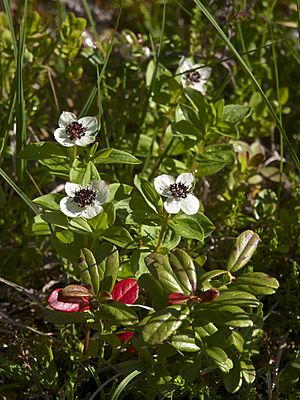Dwarf cornel facts for kids
Quick facts for kids Dwarf cornel |
|
|---|---|
 |
|
| Growing next to lingonberry in Norway | |
| Scientific classification | |
| Genus: |
Cornus
|
| Species: |
suecica
|
Cornus suecica, often called the dwarf cornel or bunchberry, is a type of flowering plant. It belongs to the dogwood family, Cornaceae. This plant grows in cool places, like chilly parts of Europe and Asia. You can also find it in some areas of northeastern and northwestern North America.
What Does the Dwarf Cornel Look Like?
The dwarf cornel is a perennial plant, which means it lives for more than two years. It's also a herbaceous plant, so it has soft stems, not woody ones like a tree. It grows from underground stems called rhizomes. This helps it spread.
This plant usually grows up to 20 cm (8 inches) tall. It has a few pairs of leaves that grow directly from the stem. These leaves are opposite each other. They are about 2–4 cm (3⁄4–1+1⁄2 inches) long and 1–3 cm (1⁄2–1+1⁄4 inches) wide. Each leaf has 3 to 5 veins starting from its base.
The dwarf cornel's actual flowers are quite small and dark purple. They grow in a tight cluster. This cluster is surrounded by four large, white, petal-like parts called bracts. These bracts are about 1–1.5 cm (3⁄8–5⁄8 inch) long and make the plant look like it has a big white flower. After the flowers, the plant produces bright red berries.
Where Does the Dwarf Cornel Grow?
Cornus suecica likes to grow in open, wild areas. You can find it on heaths, moorlands, and in mountains. It often grows under taller plants, like heather (Calluna vulgaris).
This plant is found almost all around the northern parts of the world. However, it's not found in the middle of Asia or North America. In North America, it grows in Alaska (U.S.) and British Columbia (Canada). It's also in eastern Canada, including Labrador, New Brunswick, Newfoundland, Nova Scotia, and Quebec. You can also find it in Greenland. But it doesn't grow in the areas between these places.
Sometimes, Cornus suecica grows near another plant called Cornus canadensis. Cornus canadensis is a forest plant, while Cornus suecica prefers open, wet areas. When these two plants grow close in places like Alaska, Labrador, and Greenland, they can sometimes cross-pollinate. This means they can mix their genes. When they do, they create new plants that are a mix of both types. This process is called hybridization.

